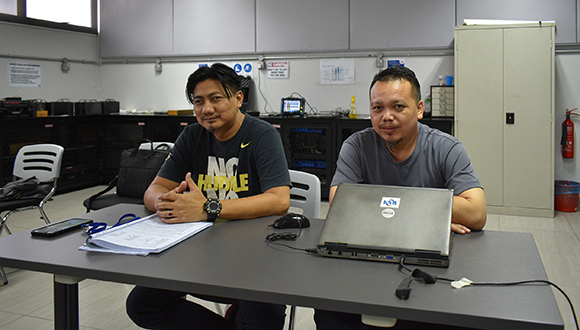Fri, 06 March, 2020
Huzairie and Sharifuddin both work for KNM Group in Malaysia, one based in Kuantan and the other in Malacca.
Sharifuddin, who holds a diploma in civil engineering, started his career as an NDT technician at Total Sterling. Five years later he landed an opportunity in KNM and has been working as an NDT technician specialising in the fabrication of pressure vessels for 14 years.
While highlighting that pressure vessels are a very high-risk piece of equipment used in oil tanks, reactors and bullets, Sharifuddin explained that proper inspection of the equipment is important and using the correct NDT inspection techniques following specific standards becomes very critical.
Huzairie, meanwhile, started his career as an MPI inspector at Total Sterling. He later progressed to the role of UT technician and started getting involved with the inspection of platforms that require extensive UT inspection.
In 2003 Huzairie joined KNM and has had continuous career progression ever since, moving from UT technician to CB scan technician and is now in charge of the ToFD department at his company. He explained that he likes the diversity of jobs he can get involved in at KNM and that he is able to learn new skills as he gets exposed to new projects.
Huzairie was initially introduced to ToFD through internal training. However, recently, his company’s clients require the contractor to be certified. In order to meet the requirement of their client, the company has sponsored both Huzairie and Sharifuddin’s training and certification at TWI. This is also a very good opportunity for Sharifuddin to upgrade the CSWIP UT certificate that he acquired in 2014.
Huzairie mentions that all the recent inspections on the vessels are being done using ToFD. This is because of the advantages of this technique, including the low amount of time it takes and the high levels of safety compared to other methods of NDT. For instance, Radiographic Testing is a very time-consuming method and has safety issues and UT has some limitations that need to be supplemented with ToFD.
KNM currently has one central ToFD team which is managed by Huzairie, but Sharifuddin is excited to complete his training as, once he is certified, his company will be able to set up a new ToFD team in Malacca with Sharifuddin promoted to the head of this new department.
Huzairie mentions that, although he is familiar with ToFD and has been using the technique for a very long time, holding a CSWIP certificate adds an additional value to him by giving his clients more confidence in the quality of his work. He also believes that freelancers would benefit from holding a globally recognised certification as they will have a better chance of getting projects with higher pay.
Emran, who delivered the training, says that both candidates were very hardworking and enthusiastic. He also highly recommends anyone who works with UT or Phased Array to consider ToFD technique to add to their skillset. Even though some industries separate these two techniques from each other, Emran suggests that those who are involved in pipeline inspection or pressure vessels would especially benefit from having the knowledge of ToFD and PAUT.
Find out more about our Non-Destructive Testing (NDT) training courses in South East Asia.
 Huzairie and Sharifuddin at TWI's Training Centre in Kuala Lumpur
Huzairie and Sharifuddin at TWI's Training Centre in Kuala Lumpur